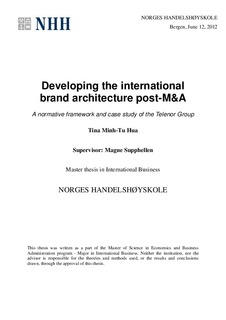| dc.description.abstract | This thesis explores the guidelines that brand managers should follow when branding a newly
merged or acquired subsidiary. It does this within the context of international brand
architecture management. M&As are more popular than ever, although most fail to meet
performance goals. Numerous scholars warn that this because the brand is overlooked in
favour of financial, operational, and legal issues in the due diligence process. This thesis
seeks to answer the following questions:
1. After a horizontal cross-border M&A, which guidelines should brand managers follow in
order to design an international brand architecture with high brand performance?
2. To what extent does Telenor follow the guidelines identified in RQ1 when developing its
international brand architecture post-M&A?
The key findings from the theoretical review are presented in a normative framework and can
be divided into four main categories: brand considerations, firm characteristics, national
culture, and industry conditions. The normative framework has two purposes: The first is to
evaluate Telenor's official brand architecture framework and guidelines. The second is to
assess the branding decisions Telenor made for DTAC in Thailand and DiGi in Malaysia, and
compare these to the recommended approaches set forward by the normative framework. It is
concluded that international brand architecture is a multifaceted and dynamic concept, and its
management must be adapted to specific contexts. The findings reveal that Telenor's
framework is mostly based around business areas and therefore too simplistic. Moreover, the
branding decisions made for the two cases are not consistent with the official framework.
This suggests that decisions are made ad-hoc, independent of guidelines, and possibly even
based on managerial preferences. The managerial implication is consequently that Telenor
should improve its existing framework by extending the scope and adding a theoretical
foundation. The guidelines should be communicated clearly and enforced thereafter. | no_NO |
